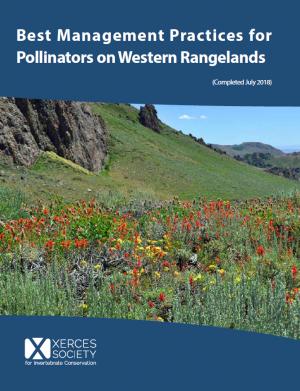
By Stephanie McKnight, Candace Fallon, Emma Pelton, Rich Hatfield, Aimée Code, Jennifer Hopwood, Sarina Jepsen, and Scott Hoffman Black.
Rangelands comprise the majority of public lands in the western United States, spanning a huge diversity of ecological regions, habitat types, and elevations—from grasslands to sagebrush steppe to pinyon-juniper woodlands to mountain meadows—and supporting some of the highest diversity of bee species in the country, as well as many butterflies, moths, and other pollinators. Many pollinator species in the West are declining and at-risk due to stressors including habitat loss, pesticides, disease, and the effects of climate change—and a lack of pollinators on rangelands can have major ecological and economic impacts.
To help land managers incorporate pollinator-friendly practices into rangeland management, the Xerces Society for Invertebrate Conservation has published Best Management Practices for Pollinators on Western Rangelands. These best management practices (BMPs) were developed for federally managed rangelands that span the eleven western United States: Arizona, California, Colorado, Idaho, Montana, Nevada, New Mexico, Oregon, Utah, Washington, and Wyoming.
The management practices addressed in the BMPs include grazing, mowing, prescribed fire, and pesticide use, as well as recommendations on how to address pollinators in restoration projects, invasive nonnative invasive plant management, managed pollinators (e.g., permitting honey bee apiaries on public land), recreation, and climate change impacts. The BMPs also provide an introductory overview of major pollinator groups (bees, butterflies and moths, other invertebrates, and vertebrates), their status, and threats as a primer on these animals and their habitat needs. In addition, the BMPs outline methods to monitor pollinator populations, a comprehensive literature review, and tables detailing native pollinator phenology, conservation status, ecoregion associations, and habitat requirements.
Incorporating pollinators into rangeland management is essential to help maintain or recover pollinator populations and also maintain healthy rangelands for plants, wildlife, livestock, and the people who rely on them. While there is still much to learn, these BMPs provide actionable, practical recommendations that enables land managers to help conserve pollinators on public lands in the West.
Additional Resources
- Literature Review
- Native bee genera lists by ecoregion and US Forest Service region with floral and nest plant associations
- At-risk butterflies and moths and their host plants in the West
NOTE: These guidelines were completed in June 2018. While additional literature relevant to managing rangelands for pollinators has been published since, the BMPs provide actionable, practical recommendations that enable land managers to help conserve pollinators on public lands in the West.
